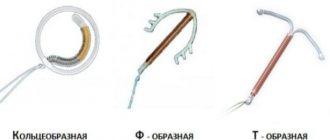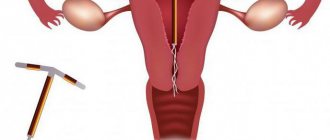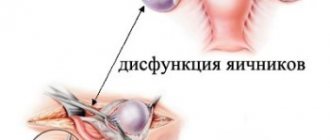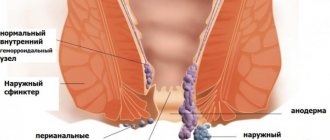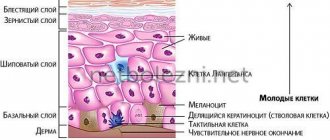Description of the procedure
Mirena is a hormonal system containing levonorgestrel.
The spiral is inserted into the uterine cavity, the hormone is gradually released, providing its contraceptive effect. The installation period for an IUD is 5 years. Mirena is used not only to protect against unwanted pregnancy, but also for therapeutic purposes for uterine fibroids and some other conditions. Removing the IUD takes a few minutes:
- The doctor uses forceps to grab the antennae, which are freely located in the pharynx of the cervical canal.
- Gently pulls the spiral out of the uterine cavity.
- It is completely removed manually.
If necessary, a new IUD is installed.
Medical manipulations usually do not cause pain; more often they bother you after the procedure. Bloody discharge, short-term spasms and convulsions may also appear. Such symptoms are considered normal.
Long-term wear may result in complications such as ingrowth of the helix or incorrect angle of inclination. The doctor checks his assumptions using ultrasound, after which the IUD is surgically removed. The “wandering” contraceptive is found and removed using hysteroscopy.
Up to what age can IUD be inserted?
There are no age restrictions for using an IUD. An intrauterine device can be installed in a woman of reproductive age from 18 to 49 years old or before the onset of menopause. Although experts have different opinions about the age at which an intrauterine device should be placed.
It is believed that nulliparous women and women over 40 are not recommended to use the IUD for pregnancy. For those who have not given birth - due to complications (ectopic pregnancy, inflammation of the genital organs and, as a result, infertility in the future), and for those of “age” - allegedly due to the risk of cancer.
The installation of an IUD in itself in women over 45 years of age does not increase the risk of developing cancer. It’s just that in this age category, the likelihood of developing various kinds of pathologies already increases due to lifestyle, habits, and careless attitude towards one’s health, but these problems do not arise because of the IUD.
You are 45 years of age or older. You can safely use an IUD if:
- You have regular periods;
- you have a permanent and only sexual partner;
- Your doctor does not find any contraindications to inserting an IUD.
You are a young girl of 18 years old or a young nulliparous woman. There are restrictions on your use of this method of contraception. But there are situations when another type of protection against unwanted pregnancy is not suitable or is contraindicated. Consult your doctor - there are always exceptions to every rule. A specialist will select a spiral that is less “harmful” for you.
When the IUD is inserted: does the cycle affect the day the IUD is inserted?
The IUD is inserted on days 5-7 of the menstrual cycle. At this time, the cervix is slightly open, which makes insertion of the IUD easier. In addition, during this period the risk of unwanted pregnancy is minimal.
After insertion of a copper-containing IUD, the volume of discharge during menstruation may increase slightly. Conversely, the use of the Mirena hormonal system reduces the intensity of bleeding. Amenorrhea – a complete absence of menstruation – may occur, and this is a variant of the norm.
Read more about how the menstrual cycle changes after the insertion of an IUD.
The optimal time to remove the intrauterine device is 1-2 days of menstruation, when the uterus becomes softer.
If planned removal of the IUD is planned, you should start using alternative methods of contraception about a month before the procedure. This will avoid unwanted pregnancy in the “postoperative” period.
In case of severe symptoms of inflammation or pain, the coil is removed immediately, regardless of whether menstruation has occurred.
Most often, the installation of an IUD, regardless of the type of device and the age of the woman, is carried out either on the first day of menstruation or immediately after the end of menstruation. In this case, there is complete confidence that the woman is not pregnant. In addition, the cervical external pharynx, through which the anti-pregnancy device will be inserted, is in a slightly open state, which greatly facilitates the procedure for inserting the IUD and reduces unpleasant or painful sensations.
This is especially important if the IUD is installed in a young nulliparous woman. Because the main difference between the cervix in women who have given birth and women who have not given birth is the shape of the external pharynx. Before childbirth, it has a dotted appearance, and after childbirth, it has a slit-like shape. Typically, inserting the IUD into the uterus in women who have given birth does not encounter any difficulties, which is facilitated by the structure of the cervical canal. But for nulliparous women, it is necessary that the external opening of the cervix be slightly open. This occurs on any day of menstruation.
An intrauterine device is usually installed after childbirth after 6-8 weeks, and after a cesarean section - after 6 months.
The insertion of an IUD is possible on any day of the cycle, but the following conditions must be met:
- absence of pregnancy;
- absence of inflammatory diseases and bleeding at the time of IUD installation.
Healthy women with no history of gynecological diseases can have an IUD containing copper, silver or gold. The shape of the spiral does not matter. Women suffering from endometriosis or having uterine fibroids should give preference to the Mirena hormonal system.
IUD installation process
Before installing an intrauterine device, an examination should be scheduled to exclude the presence of infections and pathologies associated with the reproductive organs. The standard list of diagnostic procedures looks like this:
- smears of the cervix and vagina;
- tests for syphilis, hepatitis and HIV;
- colposcopy;
- general urine test;
- tests that detect sexually transmitted infections;
- ultrasound examination of the uterus.
An ultrasound is prescribed not only to make sure that a woman has no changes that would prevent the use of an intrauterine contraceptive. Its purpose is also to make sure that the woman is not pregnant at the time of installation of the IUD. To do this, you will have to do a test to determine the level of hCG.
Before inserting the IUD, it is recommended to abstain from sex for 7-10 days.
The installation procedure is carried out exclusively in a gynecological office under sterile conditions. The woman sits in a chair with her feet on the holders. Before inserting the IUD, the doctor treats the cervix and vagina with a disinfectant. Additionally, local anesthesia is performed. Usually a special gel is used for anesthesia, sometimes injections.
Only after this, the doctor, using special instruments, opens the cervix, measures the depth, and then inserts the contraceptive into the uterine cavity. The doctor brings the so-called “antennae” up to 2 cm long out into the vagina. This is done so that the spiral can be removed. During hygiene procedures, a woman should check from time to time whether these “antennae” are in place.
The installation procedure is virtually painless. Only sometimes women feel pain, which quickly passes. Some women experience attacks of dizziness and fainting. But this is an extremely rare phenomenon that goes away after a few minutes.
With the IUD you can have sex within a few days. In the first month, until the immune system adapts to the presence of a foreign body, it is better for a woman to refrain from visiting the bathhouse or swimming pool. Strong physical activity should also be avoided.
The main reasons when you can remove the intrauterine device before its expiration date.
Only a gynecologist should remove the intrauterine device, since only a specialist will do it correctly, he will be able to determine the possible consequences of using the IUD, and also, if necessary, prescribe treatment.
So, the most common reasons for removing the spiral are the following:
- If the IUD has moved inside the uterus. This can be determined by the antennae, if they have become longer or shorter. Then the woman needs to remove the old IUD and install a new one. When does the IUD expire? Many such contraceptives are designed for a period of 3–5 years in the uterus; some types work for up to 10 years. If during this period the spiral is not removed, then serious inflammatory processes may begin in the woman’s uterus, as well as the growth of the endometrium. Pregnancy. Yes, there is evidence that even with the IUD, women get pregnant. Moreover, the IUD must be removed both during a normal pregnancy and during an ectopic pregnancy. The situation when it is better to remove the spiral is a woman’s desire to become a mother. After removing the contraceptive, pregnancy can occur almost immediately. Doctors used to recommend refraining from trying to conceive for some time, but today this is advisable only if there are any complications, such as inflammation of the endometrium. If, after installing the IUD, uterine fibroids begin to enlarge. For inflammation of the uterus and uterine appendages. In such a situation, removal of the IUD is accompanied by taking a course of antibiotics.
DETAILS: Treatment methods for viral warts
Is it possible to remove the intrauterine device yourself?
Despite the apparent simplicity of the procedure for removing the IUD, doctors strongly do not recommend doing it yourself, because there is a high risk of damaging the uterus and vagina, and you can also get an infection. Removal of the intrauterine device must be done in a gynecological office under sterile conditions. During removal of the coil, the woman does not experience any pain, so anesthetics are usually not required.
This is done in the first days of the menstrual cycle. The gynecologist conducts an examination and pulls out the spiral by the antennae; if for some reason the antennae are damaged, then microsurgical intervention is performed. After removing the device, a vaginal smear is usually taken.
Can there be an ectopic pregnancy due to an IUD?
Yes, this happens. In rare cases, such a pregnancy goes well, and the woman manages to carry the child to term. The expectant mother should be observed by a gynecologist, monitor the condition of the fetus and monitor her own sensations. Quite often, pregnancy with IUD ends in miscarriage in the first trimester. This statement is true for both Mirena and non-hormonal IUDs.
The IUD located in the uterine cavity increases the risk of ectopic pregnancy. The following symptoms indicate the location of the fertilized egg outside the uterus:
- delayed menstruation;
- pain in the lower abdomen (usually on the side of the affected tube);
- bloody discharge from the genital tract.
Ultrasound will help make an accurate diagnosis.
Yes it is possible. The spiral does not affect lactation; the hormone levonorgestrel does not pass into breast milk. The chosen method of contraception is not dangerous for the child. Before installing the spiral, you must consult a doctor.
An intrauterine device (IUD) is a method of preventing unwanted pregnancy. It is a small plate, stick, spring, etc. from various materials with “antennae”. There are more than 50 types of IUDs, differing in appearance and shape.
Installation of an intrauterine device into the uterine cavity prevents the egg from attaching to its walls.
One of the advantages of an intrauterine device is that it is installed for several years. After this, the IUD should be removed.
Removal of the intrauterine device must be done on time, after the recommended period has expired, otherwise the IUD may begin to grow into the walls of the uterus, which will lead to serious consequences and complications.
When should an IUD be removed?
Removal of an IUD (intrauterine device) is a gynecological procedure, the purpose of which is to correctly remove the device from the uterine cavity.
1. Expiration of the recommended service life.
The packaging or instructions for each spiral must indicate for what period this contraceptive is designed. Most of the spirals are installed for 3-5 years, although there are also modern spirals that can last 7 or even 10 years.
There are two types of IUDs: copper IUDs, which prevent pregnancy by slowly releasing copper, and hormonal IUDs, which release hormones. Copper IUDs last for about ten years, while hormonal IUDs last for five years.
After the specified period, the IUD must be removed. Otherwise, changes and inflammation will begin in the uterine cavity, leading to deterioration of health.
2. Expulsion of the intrauterine device (displacement of the IUD relative to its original correct position).
Sometimes it happens that after installation the intrauterine device is displaced and cannot guarantee the expected contraceptive effect. Often in such situations, the device “falls out” of the vagina on its own.
And when re-expulsion of the IUD, it is necessary to select an alternative method of contraception.
3. Pregnancy caused by an IUD.
Like other contraceptives, the IUD does not provide a 100% guarantee of preventing pregnancy - both uterine and ectopic. If you have any suspicions about conception, contact your gynecologist immediately.
4. Planning pregnancy.
Pregnancy can occur almost immediately after removal of the intrauterine device.
If the use of the IUD as a contraceptive has not caused any problems, the woman’s health is good and she is ready to become pregnant, then removing the IUD is quite enough for this.
5. Development or growth of a benign tumor process in the uterus (fibroids, fibroids) after installation of an IUD.
A small uterine fibroid is not a contraindication for the installation of an intrauterine device; the only important condition is that there should be no deformation of the uterine body. In this case, you should choose an IUD with a progestin. However, if myoma or fibromyoma appeared during the use of the IUD or began to grow after its installation, the contraceptive must be removed.
6. Acute inflammatory processes in the pelvic organs.
7. Presence of an ascending sexually transmitted infection (gonorrhea).
8. Uncontrolled bleeding from the uterus associated with the presence of an IUD in the uterine cavity.
DETAILS: Services of a paid gynecology department in Moscow
9. Diagnosis of malignant neoplasms of the pelvic organs.
How is the intrauterine device removed?
The intrauterine device is removed quickly, easily and painlessly if no inflammation occurs while wearing it. The procedure must take place under sterile conditions on an outpatient basis in a clinic or in a hospital and be carried out exclusively by a specialist.
The IUD removal procedure is usually performed during menstruation.
The gynecologist preliminarily examines the woman and, if everything is in order, removing the IUD will not take much time: to do this, you just need to pull the antennae of the spiral.
If, at the time of removal, the antennae break off, then in some situations it is possible to use special hooks to capture the IUD, but this manipulation should be carried out under ultrasound guidance.
In the event that the threads of the spiral are lost or there are other difficulties in removing it, they resort to the method of hysteroscopy. Hysteroscopy is usually performed in a hospital.
In the case of visual identification of the IUD in the uterine cavity and the use of a hysteroscope, removal of the IUD does not differ from standard hysteroscopy. In this case, the end of the IUD is grabbed with special forceps and removed from the uterine cavity along with the hysteroscope.
Under no circumstances should you try to remove the intrauterine device yourself! There is a high risk of damage to the uterine lining and infection.
In the vast majority of cases, no complications arise when removing the IUD. Removal of an IUD is a common everyday procedure performed in gynecological clinics; compliance with the rules and techniques guarantees painless and uncomplicated removal.
The cost of installing a spiral
The installation of an intrauterine device occurs on an outpatient basis; if no side effects occur, then after the procedure the woman can immediately go home.
The price of installing an IUD consists of the cost of the IUD itself and the services for its installation, and completely depends on the price level in the clinic. This procedure can be performed not only in a commercial clinic, it is also possible in a district antenatal clinic, where the price of installing the IUD will be low, you will only need to pay for the IUD itself. In some clinics, the price may also include the cost of an anesthetic; it is better not to refuse it.
But it’s still not worth focusing only on price, since the intrauterine device is installed for several years, so it’s better not to skimp on the services of an experienced gynecologist and high-quality material.
When is it necessary to remove the coil?
The intrauterine device must be removed if certain factors require it. First of all, this is a woman’s desire to conceive a child, and also if the use of this drug has caused serious side effects. For example, menstruation has become painful and prolonged, too profuse, accompanied by pain and cramps.
The procedure for getting rid of the product itself is simple, and this action is possible on any day of the cycle. However, during menstruation the process will be easier. As you know, during this period the cervix acquires different properties: during menstruation it becomes pliable and soft. Removing the intrauterine device involves using the same methods as when installing this contraceptive.
At the first stage, the gynecologist clarifies the position of the uterus and the thread itself, which is attached to the spiral rod. Then the tip of the thread is caught with surgical forceps or tweezers. After this, the spiral is pulled out, very carefully, at a certain angle. The characteristic flexible antennae with which the spiral is equipped fold as they pass through the cervical canal.
When to install the spiral
To prevent conception, if desired, a woman can install an intrauterine device. The procedure must be carried out by a medical specialist with the necessary qualifications.
Stages of IUD insertion:
- two-manual gynecological examination on a chair to determine the location of organs and the intended installation location of the spiral;
- antiseptic treatment of the skin and mucous membrane of the external genitalia;
- insertion of a gynecological speculum (to display the external uterine opening);
- using a clamp, the upper uterine lip is grabbed and pulled back;
- insertion of a probe directly to the fundus of the uterus to measure the length of the uterine cavity;
- removing the spiral from the packaging;
- a spiral is inserted through the cervix in a special tube;
- after the IUD reaches the bottom of the organ, the tube is removed by pulling;
- trimming the antennae of the contraceptive device;
- removal of gynecological instruments.
It is very important that the spiral is installed correctly
This procedure may cause discomfort and minor pain if all the doctor’s manipulations are performed correctly. The mini-operation takes about 5 minutes, after which the woman can safely go home.
The gynecological procedure for inserting an IUD should not be performed if the diagnosis reveals that the woman has contraindications:
- acute stage of inflammatory and infectious diseases of the genitourinary system and genital organs;
- cancer of organs located in the pelvic area;
- any form and stage of STD;
- large tumor formations;
- pregnancy;
- allergy to the material from which the IUD was made;
- abnormal deviations that prevent the correct installation of the contraceptive.
An IUD can be inserted on any day of the cycle if the woman is absolutely sure that there is no pregnancy. Girls who decide to undergo this procedure often have difficulty placing the IUD before or after their period.
It is best to insert the IUD during menstruation
Gynecologists do not recommend inserting an IUD after menstruation, despite the fact that it is not prohibited. Inserting a contraceptive outside of your period may cause more pain. This is due to a narrowing of the uterine pharynx, increased tissue tone and difficult access to the attachment site.
The most suitable period, according to experts, is the 1st or 6th day of menstruation. Adaptation in this case is much easier, and the risk of developing inflammatory or infectious processes is less.
There is a relationship between menstruation and the intrauterine device. Menstruation with the Mirena coil or another IUD model changes the nature of the discharge in the first cycle.
In 70% of women, periods become more abundant and longer due to the adaptive reaction of the endometrium to a foreign object. Hormonal imbalance, which occurs due to disruption of the natural processes of egg formation and maturation, also has an impact.
After installing the IUD, the duration of menstruation increases
Normally, menstruation may be heavy, but not excessive. If the discharge becomes symptomatic of bleeding, there are cramping attacks, or severe pain in the abdomen, you should immediately contact a gynecologist; the IUD may not be rejected from the body.
When is it better to insert an IUD - before or after menstruation? It is recommended to carry out this procedure on the 3rd or 5th day of the menstrual cycle.
During this period, the uterine cervix is slightly open so that the manipulation is the least traumatic and painless. Menstruation is a sign of absence of pregnancy, which means it is safe to insert an IUD, and there are no obstacles to this.
It’s probably not worth saying that an IUD should only be installed in a hospital setting. When a contraceptive is installed after childbirth, you should wait a couple of months. After an abortion, an IUD is inserted immediately. After cesarean - six months later.
Anesthesia is not used during manipulation; there is pain, but it is quite tolerable. Using a special device, the gynecologist inserts a contraceptive into the uterus. Be sure to check the position and shorten the antennae. Thanks to the antennae, a woman can independently determine how the IUD is located.
At the end of the procedure, there may be pain and slight discharge. For a couple of months after installation, periods are heavy and painful, during which time the IUD can spontaneously expel. You should take care for a week, do not expose yourself to physical activity, and do not take hot baths. You should abstain from sex. Laxatives are contraindicated.
Reliability as a means of contraception
- You can remove the IUD during your period using local anesthesia. Using hysteroscopy under general anesthesia (when there are no antennae of the IUD and other obstacles). Through the female abdominal cavity. Such removal of the spiral is carried out in cases where it is impossible to perform the procedure through the cervical canal.
When choosing a spiral, a woman needs to remember that after a certain time it will have to be removed. A young lady who is protected from conception with the help of an IUD must constantly monitor the health of her genital organs, since there is a foreign body in her uterus, and the body will certainly react to this (for example, aseptic inflammation of the inner uterine surface may occur).
It is known that some drugs (antibiotics, aspirin) reduce the contraceptive effect of the IUD. Consultation with your attending physician is necessary. If a long course of taking a potentially dangerous drug is required, it is recommended to additionally use condoms or spermicides during treatment.
This method of contraception is considered the most reliable of all available, and its effectiveness is 99.9%.
Moreover, the woman simply did not notice that her spiral had fallen out. And it falls out in those who have just given birth to a child, and in nulliparous women due to the wider passage of the cervical canal.
Combining these two methods of contraception increases the inability to conceive up to 100%.
If the IUD is installed correctly, then after its removal a woman can become pregnant within a year. In addition, many women have noted the positive psychological effect of using an intrauterine device.
Unlike oral contraceptives, the IUD does not require any restrictions or daily monitoring. She also doesn’t feel like a man at all. The silver intrauterine device not only protects against unwanted pregnancy, but also reduces the risk of inflammatory processes in the pelvis.
Pros and cons of the intrauterine device
The advantages of this method of contraception include:
- Its effectiveness, according to various sources, is from 95% to 99% in preventing unwanted pregnancy;
- There is no need to constantly take hormonal pills;
- Long validity period, which allows you to save money on the purchase of other contraceptives;
- Can be used by nursing women;
- There is no need to restore hormonal levels after removing the IUD;
- IUDs with hormones have a positive effect on a woman’s menstrual cycle and the reproductive functions of the uterus.
This method also has disadvantages:
- Can only be used by women who have given birth;
- The IUD will not protect against sexually transmitted diseases, so it can only be used on women who have one regular sexual partner
- A woman needs to independently control the location of the spiral; the correct position can be determined by the “antennae”.
- Women who have an intrauterine device installed need to visit the gynecologist more often, this should be done at least once every six months.
Description of the procedure
The effectiveness of this contraceptive depends on the type of IUD, as well as the correct installation. The average duration of the contraceptive function of the IUD lasts 5 years. There are modern types of IUDs that effectively prevent conception for 10 and even 15 years.
The spiral is removed after its expiration date or at any time at the woman’s request. The removal procedure is carried out during menstruation and consists of the following steps:
- the woman sits on the gynecological chair;
- all natural secretions are removed from the vagina;
- After the examination, the doctor removes the contraceptive by simply pulling the special antennae.
DETAILS: Iodine for warts - instructions from doctors
After removal of the IUD, an ultrasound of the pelvic organs is required.
If the patient did not have any inflammatory diseases while wearing the intrauterine contraceptive, then its removal is completely painless. To avoid possible pain, it is recommended to perform the procedure using anesthesia.
If the spiral cannot be removed in the usual way, because some of its parts have grown into the wall of the uterus (this, alas, sometimes happens), it is removed using a diagnostic curettage procedure. At ON CLINIC, such manipulation, due to its increased traumatic nature, is necessarily performed under the visual control of a hysteroscope. This approach allows the operation to be performed as carefully as possible and to avoid possible complications.
Is pregnancy possible with the IUD?
Yes, this happens. In rare cases, such a pregnancy goes well, and the woman manages to carry the child to term. The expectant mother should be observed by a gynecologist, monitor the condition of the fetus and monitor her own sensations.
The IUD located in the uterine cavity increases the risk of ectopic pregnancy. The following symptoms indicate the location of the fertilized egg outside the uterus:
- delayed menstruation;
- pain in the lower abdomen (usually on the side of the affected tube);
- bloody discharge from the genital tract.
Ultrasound will help make an accurate diagnosis.
Yes it is possible. The spiral does not affect lactation; the hormone levonorgestrel does not pass into breast milk. The chosen method of contraception is not dangerous for the child. Before installing the spiral, you must consult a doctor.
Removal of an IUD: consequences, without mustache, price. Pregnancy after IUD removal - paid MedOk clinic
Any doctor will confirm to you that this removal is a routine gynecological procedure for women and no complications are expected. But sometimes, when examining the vagina, the doctor does not detect the thread. Typically, this condition occurs when the thread gets pulled into the cervical canal because it is too short.
If this happens, a sonogram or ultrasound helps confirm this factor. Even if the end of the thread is not found, the spiral is removed with special tools, and the uterus is not damaged. In the rarest cases, the ends of the spiral become tightly fixed in the uterine walls and it becomes difficult to get it out.
Therefore, the doctor prescribes hysterography and ultrasound. An effective diagnostic method is hysteroscopy, during which the uterus is examined using a special optical device. To remove the intrauterine contraceptive device, the walls of the cervix are expanded with a special device, and removal is performed using local anesthesia.
What are the features of installation after childbirth and abortion?
Women who have recently given birth or had an abortion, as a rule, do not want another pregnancy. In order to preserve sensations during sexual intercourse, but at the same time prevent unwanted conception, they strive to install an IUD.
Even more interesting:
Echinococcal liver cyst surgery
Apple cider vinegar for dandruff reviews
After childbirth, the IUD cannot be placed immediately, but after some time.
When the procedure can be performed after childbirth or a medical abortion, and whether it is possible to insert an IUD without menstruation - these are questions that often interest women. The menstrual cycle in this case does not play a big role if there are no contraindications. Regarding the past pregnancy, each case should be considered separately.
Cost of services
Dear patients! You can find a full list of services and price list at the reception or by phone. The administration tries to promptly update the price list posted on the website, but in order to avoid possible misunderstandings, we advise you to check the cost of services on the day of contact at the reception or call center by phone. The posted price list does not constitute an offer.
The cost of an intrauterine device ranges from 500 to 10 thousand rubles (for Mirena).
An anti-pregnancy device can be purchased at a pharmacy (if you know exactly which IUD you need) or purchased from a doctor.
The cost of installation depends on the region of your residence and the type of medical institution. In a public clinic, if there is a compulsory health insurance policy, the service may be completely free or cost a small “symbolic amount.” In a private clinic, the cost of inserting an IUD can range from 3,000-5,000 to 25,000 rubles. It all depends on your wallet.
| Manufacturer | Name of the Navy | Cost, rub. | Is it sold in a pharmacy? |
| Bayer | Mirena (hormonal) | 11 500 | Yes |
| Multilan AG | Multiload KU-375 | 3 935 | Yes |
| Schering-Plough | Nova T No. 1 | 2 650 | Yes |
| Gedeon Richter | Goldlily Exclusive | 3 923 | Yes |
| Bayer Pharma AG | Nova T with copper | 2 999 | Yes |
| Simurgh | Juno Juno T Au | 6 500 | Yes |
| SMB | Copper TCu 380A | 650 | Yes |
Installation of an IUD after the birth of a child or abortion
There is a myth that while a woman is breastfeeding, she cannot get pregnant, but this is not true. The female body is ready for childbearing literally a month after giving birth, so you need to protect yourself almost immediately. Even if you plan to have another child as soon as possible, your body still needs time to recover. If a woman is not yet planning a child, then after 1.5-3 months a spiral can be installed. It is after this period of time that the tone of the uterus returns to normal, although some doctors may advise installing an IUD immediately after the birth of the child, but only if the birth occurred naturally. When giving birth by caesarean section, the IUD can be installed only after six months.
After an abortion, regardless of whether it was natural or surgical, it is customary to install an intrauterine device immediately, that is, in the first 30 minutes after the abortion.
Pregnancy IUD video:
Why should I get an IUD after childbirth?
- The effectiveness of protection against pregnancy is more than 90%;
- an intrauterine device after childbirth is installed for a period of 2 to 8 years;
- minimal side effects in the form of pain and heavy bleeding during menstruation or their absence at all;
- absence of any discomfort during sexual intercourse;
- quick installation and affordable price;
- no effect on milk secretion;
- absence of any negative effect on the child’s body.
What is a contraindication to inserting an IUD?
- Inflammatory diseases.
- Pathological structure of the uterus.
- Benign and malignant tumors of the genital organs, especially the uterus.
- Frequent change of sexual partners, as the risk of infection transmission increases.
- An IUD should not be placed in women who experience excessive metrorrhagia (uterine bleeding).
- For complications in the early and late postpartum period.
When is the IUD placed after childbirth?
The ideal time to insert an IUD is as soon as postpartum discharge stops, during the first menstruation, since this is when the manipulation is carried out with the least damage to the cervix. But due to the fact that during lactation many women do not have menstruation, an IUD can be inserted within the next 48 hours after the birth of the child while still within the walls of the maternity hospital. An intrauterine device after a cesarean section is installed only after a few months, when the pelvic organs have fully recovered. Then, once every six months, the woman needs to visit a gynecologist to monitor the position of the IUD in the uterine cavity.
Which IUD is better after childbirth?
Only a gynecologist has the right to determine which IUD to place after childbirth. The following types of IUDs exist:
- IUDs made of plastic and metal. The mechanism of action is very simple: they prevent the fertilized egg from attaching to the uterine mucosa. Currently used extremely rarely;
- Medicinal IUDs contain either a hormonal drug or copper ions. These IUDs affect various physiological processes: the thickness of the mucus of the cervical canal of the cervix, ovulation, the mobility of male germ cells, etc.
How is an IUD installed in the postpartum period?
Before placing the IUD after childbirth, watch the video and photos, this will help you understand how it is installed and how it is located in the uterine cavity.
The installation of an IUD is carried out only within the walls of the hospital by a gynecologist, after a preliminary examination of the pelvic organs and taking smears. The manipulation is carried out on a gynecological chair. Very often, an ultrasound is required to confirm the correct placement of the IUD. As a rule, a woman may feel slight discomfort during the procedure. It should be remembered that the IUD does not protect against sexually transmitted diseases. Contraceptive pills Femulen Femulen is an oral monohormonal contraceptive drug containing a synthetic analogue of natural progesterone - ethynodiol. The drug belongs to...
What types of spirals exist
Pharmaceutical companies produce many intrauterine systems to prevent egg fertilization. The choice of a suitable spiral should be determined by the gynecologist individually, based on all the data on the condition of the patient’s body.
Contraceptives of this type are classified into two categories: generation and form. By development time (generation):
- Generation I is an inert type of product made of plastic without metal impurities. Causes inflammation and disrupts the process of egg implantation into the uterine wall. Prohibited by the Ministry of Health due to frequent adverse reactions.
- II generation – metal-containing contraceptives. A silver, copper or gold thread is wound around the leg of the plastic spiral. The contraceptive effect is an obstacle to the implantation of a fertilized female egg.
- III generation - a hormone-containing spiral that contains progestin (levonorgestrel). Gives a result of 99%.
Read more How long does an abortion take?
IUDs are available in one of three forms:
- ring-shaped - can have the shape of a circle or semicircle;
- S – shaped – fastened with spikes located on the “hangers”;
- T-shaped - have a core and “shoulders”, belong to the 3rd generation.
Each type of spiral has a number of features and disadvantages. However, the choice of the appropriate IUD model is individual for each woman.
What are the advantages of the spiral
Modern pharmacology offers many methods of contraception for women. However, pills and intrauterine devices still remain popular, providing almost 100% protection from pregnancy.
The spiral is an effective anti-conception remedy
The effect of the spiral is to disrupt the formation of the egg, due to which it cannot be fertilized. If conception does occur, thanks to the spiral, the fertilized egg is not attached to the wall and is removed from the body.
- does not require any additional contraceptive measures;
- does not affect lactation;
- rapid restoration of reproductive function after removal;
- not related to the frequency and nature of sexual intercourse;
- does not have a systemic effect.
One of the advantages of the Navy is significant savings in material resources. Spirals are installed for up to 10 years, depending on the model.
What are the disadvantages of the spiral
The intrauterine device is a foreign body for the body that disrupts natural processes, so the negative consequences of this method of contraception cannot be excluded.
Inflammation often occurs after installation of the IUD.
The disadvantages of the spiral include:
- development of inflammatory processes in the genital organs;
- do not provide protection against STDs;
- after menstruation, the position of the coil must be checked;
- not recommended for girls who have not yet given birth to children;
- installation or removal can only be carried out in a medical facility;
- increases the abundance of menstruation;
- may cause discomfort during the first time after installation
Many women complain that when installing the Mirena coil, there are no periods in the first month. Such a reaction of the body is possible and it is not considered normal. If after installation of the IUD there is no menstruation or symptoms uncharacteristic of menstruation are observed, you should urgently contact a gynecologist.
When should you see a doctor?
Another important point when using an IUD is to understand in time that there are problems with the contraceptive.
What signs might indicate this? First of all, constant monitoring of the length of the threads in the vagina is necessary - if it has changed, this may indicate that the helix has moved out of place, gone deep into the uterine cavity, or fallen out.
In addition, you should definitely consult a doctor in the following situations:
- increase in temperature of unknown etiology a few days after installation of the IUD;
- severe pain or discomfort in the pelvic area;
- vaginal discharge of an unusual color or odor;
- loss or displacement of the spiral;
- delay of menstruation by 3–4 weeks.
